The main reason for snow guards’ installation on the roof is safety of the people and the property. Dangerous accidents and even fatalities are often caused by rooftop snow avalanches. Shedding snow is also known to do severe damage to lower adjacent roofs, flashings, gutters, and landscaping. Snow guards protect everything and everyone under the roof. This article will cover why snow guards are imperative during snow season.
What to do about snow on roof
Many homeowners do not see any problem with the snow on the roof: snow is light, fluffy, and harmless. Let’s see what happens when the enormous chunk of snow accumulated on the roof begins to melt during thaw period. Once the frost sets in, this melted snow freezes up again and it weighs even more. It is not fluffy anymore, but icy and a few times heavier. Imagine, this snowpack unexpectedly sliding down and crashing everything on its way. Now it is obvious why homeowners must address the problem with snow buildup. Sure, it is possible to clean the roof regularly, but this a time-consuming and even a dangerous task. Snow retention systems are an easier way to boost the roof safety. They prevent avalanche-like descend of snow and ice from the roofs, protect the drainage system, yard buildings and parking.
Why is snow retention important?
The idea of all snow retention devices is to restrict the movement of snow by keeping it in place and thus letting it gradually melt. Even if the snowbanks exceed the snow guards’ height, safety devices still do the job of restraining or retarding the snow movement. The densest layers of snowbank are usually at its bottom, and they slide towards downslope end. For this reason, it is general practice to install snow retention devices at the eave end of the roof. Location of snow retention devices at this place has proven to be most effective.
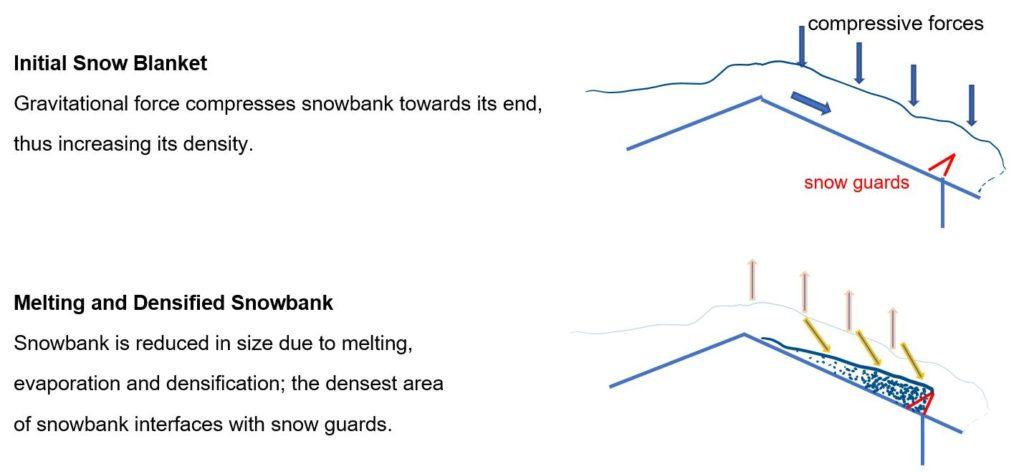
How snow guards prevent damage
Snow guards are robust tubular barriers that hold a mass of snow or ice on the roof slopes. Thanks to these barriers the load is distributed evenly. Once the accumulated snow begins to slide, it does so in small portions. As a result, we avoid sudden crush of snow and ice onto the passers-by or the property. For this reason, snow guards are required to be installed above entrance groups as well as places where people walk and cars park. They also protect the gutters and downspouts of drainage system from collapsing under the weight of snow.
Types of snow retention systems
There are two types of snow retention systems.
One type is made up of continuous horizontal components, assembled across the roof in the fence style. Fence style of snow guards are installed along with the eaves, on the line with the load-bearing wall. Depending on load qualities of the snow retention devices they may be duplicated in several rows up the slope of the roof. Fence style snow guards are connected to the roof by clamps or brackets. Depending on the roof type, brackets are connected to the ribs (on standing seam metal panels) or to the roof base (with the screws).
The second type of snow holders is point snow holders. These are snow stoppers that contain little separate items functioning as cleats. They are usually installed close to the eaves. Also depending on snow load these cleats may be repeated in a certain pattern up the slope of the roof. These snow devices are usually made of polycarbonate or of metal (steel, aluminum). Cleats type snow holders are connected to the roof by screws, to the ribs of standing seam panels. Some polycarbonate cleats are glued to the metal roofs.
Both styles of snow guards work when designed and installed properly. But we recommend using fence style snow guards, because our experience shows that this is the most reliable safety system. Our installation crews had to re-do many roofs with cleats type snow stops which did not work and had to install fence style snow guards.
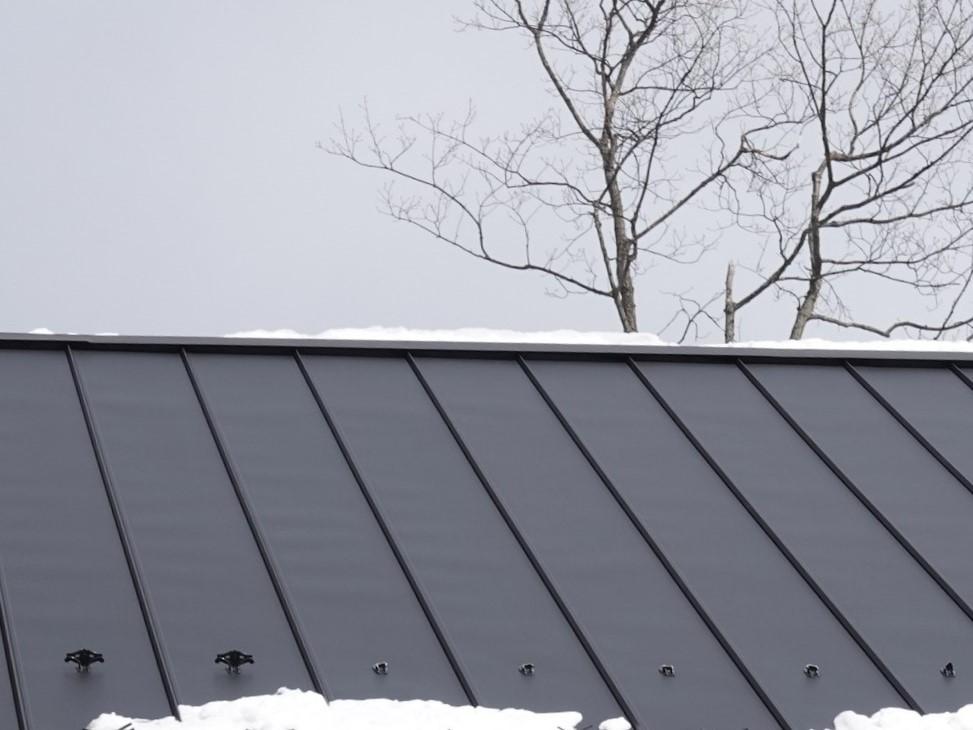
Cleats type snow guards (party broken) 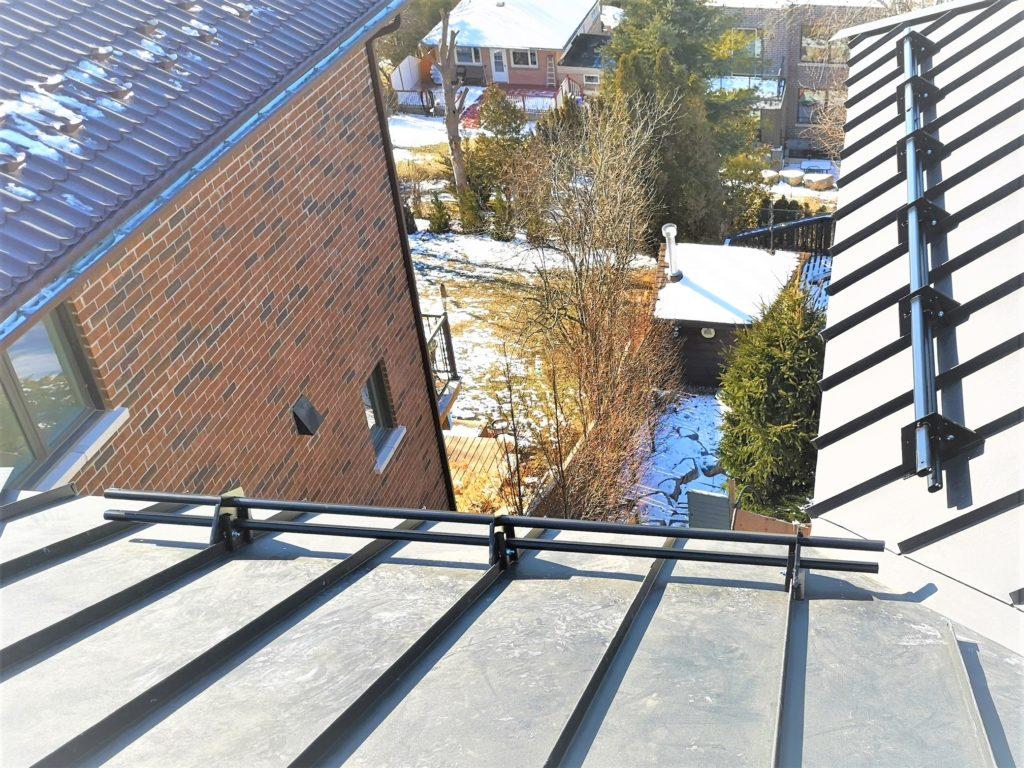
Fence type tubular snow guards
Correct placement, configuration, and installation
The final stage of roofing construction is to install a safety system. It is of vital importance to have snow guards installed over the following zones:
- Entrance to the house, above balconies and door openings
- Above skylights, chimneys, and HVAC units
- Walkways beneath the roofs
The size of roof slope, the pitch and snow load of the region are the factors which define the snow load for the roof. Based on this information, you can estimate and answer to yourself a question: “How many snow guards do I need?” Every snow retention system has the specification on load capacity. Most of our snow guards withstand a snow load of 336 lb./l.f. (5 kN/m or 500 kg/m), each bracket can withstand a load of 660 lb. (3 kN or 300 kg). Using this data, we can assess the quantity of snow retention devices, their correct placement and configuration. The rule of thumb is to install snow guards on the line with load-bearing wall along with the eaves.
There are two methods to install snow retention devices on a roof.
First method is without violation of the roof integrity. For example, we offer snow guards’ brackets and clamps for standing seam profiles, which attach to the ribs or seams without making any holes in the roof. The main benefit of expensive standing seam roof is the absence of any holes on the roof — all panels are connected to the roof base with the hidden clips and fasteners. That is why it is important to use the right snow guards which will not damage the metal roof.
Second method of snow guards’ installation is screwing down the snow guards’ brackets to the base of the roof. This approach is used for shingles roofs and metal roof profiles which are connected to the roof base with exposed fasteners–for example, metal tiles of straight rib panels. We also offer snow guards for shingles and metal roofs with exposed fasteners.
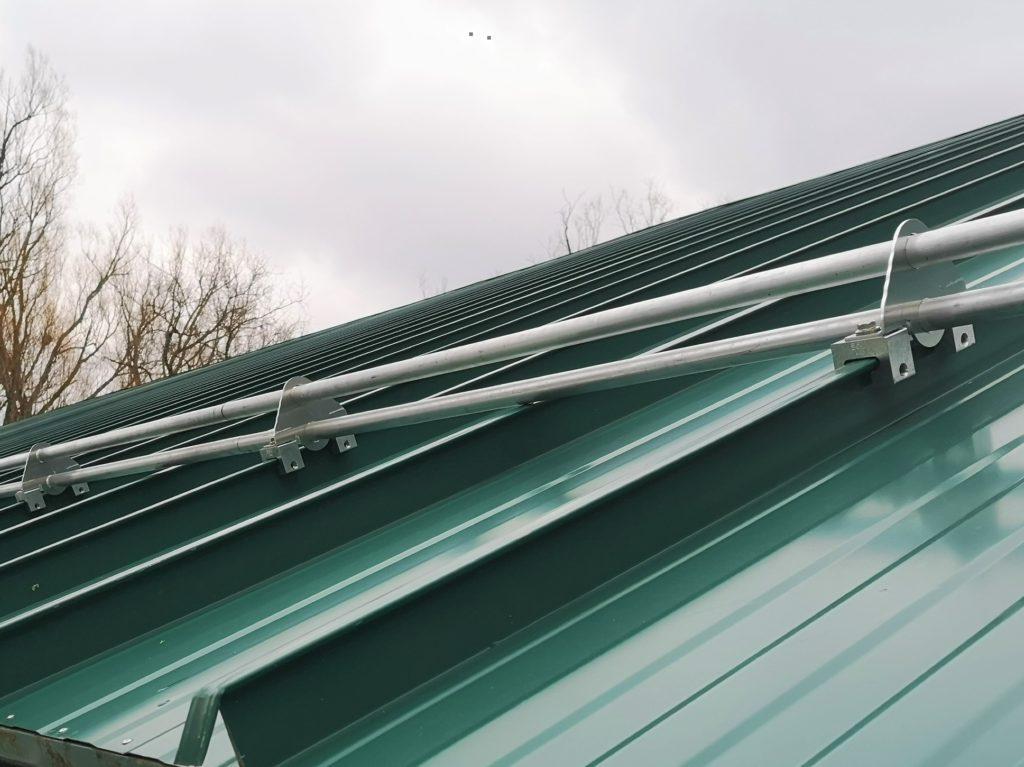
Snow guards for standing seam profile 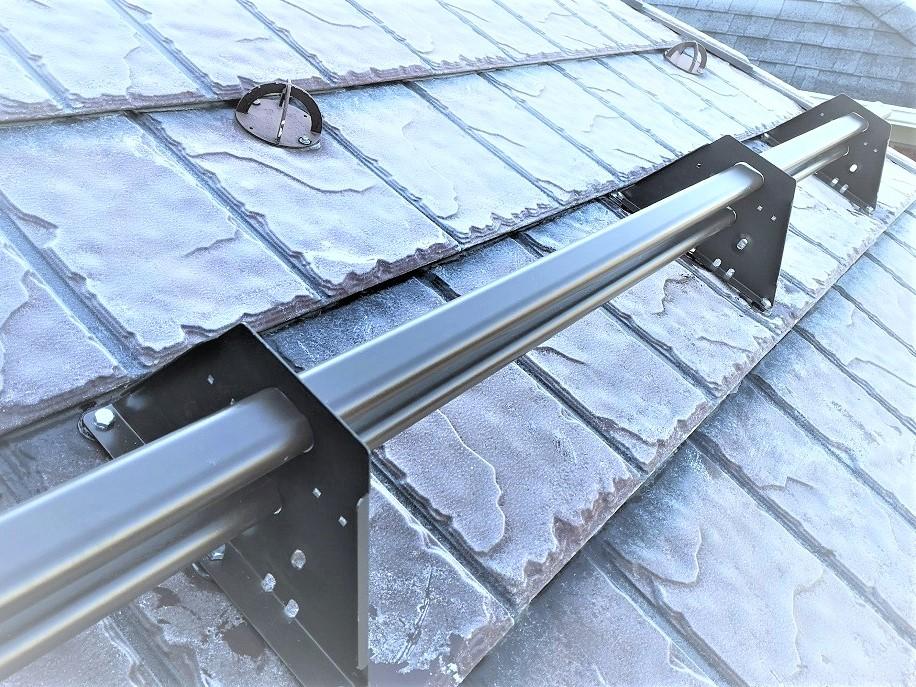
Snow guards for metal shingles
Types of snow guards and roofs
We know that the first action in snow guards’ installation process is to calculate the load of snow and ice that will have to be endured by roof safety system. The bearing load of one snow retention device is usually specified by the manufacturer of snow guards.
Second step is to find reliable snow guards for the roof. It is important to find right type of snow guards and to estimate the number of snow retention devices.
As we discussed above, there are two types of snow retention devices: fence style and cleats style. Both types may be connected by screws to the roof or clamps or brackets without destruction of the roof integrity. Both types of snow guards can be made using different materials. Depending on roof material, we can find various snow retentions devices made of steel, aluminum, bronze, stainless steel, copper, or even plastic.
There are many types of slope roofs we can differentiate in material:
- Metal (steel, aluminum, copper, zinc)
- Standing seam
- Metal tiles, straight rib panels, corrugated metal
- Metal shingles
- Asphalt shingle
- Cedar
- Synthetic and natural stale
- Concrete and clay tile
- PVC membrane
What are the best snow guards for metal roofs?
Metal roofs are very popular in snowy regions because of their exceptional qualities in winter conditions. If you have a metal roof, you need snow guards by default. Based on our experience we recommend choosing fence style snow guards. Because of their design and performance, tubular snow guards are considered the most reliable option. Let’s dwell on the benefits of using this type of snow retainers.
- Structural durability. Tubular snow guards are made of galvanized steel or aluminum, materials that can withstand heavy loads and aggressive environments, and the paint performs an anti-corrosion function. Products made of galvanized steel have a long service life.
- Versatility. They are installed on any types of roofing (metal tiles, corrugated roof, standing seam roofing, metal tiles) and in regions with changing degrees of snow load.
- Suitable for roofs with a large slope. The tubular snow retainer is one of the few capable of withstanding large volumes of snow, so it is most often installed on roofs with large slopes and steep pitches.
- Aesthetics. Despite all its quality characteristics, the tubular snow retainer is called decorative, as it fits perfectly into the overall picture of the roof and facade. The color of the tubular snow retainer can be matched to any roofing.
Final Thoughts
If you want to enhance the safety of your property, we do recommend you installing snow guards. It will take a load off your mind and off your roof during the winter months. Tubular snow guard is a reliable and versatile roofing element that has exceptional characteristics. A tubular snow cutter will faithfully serve your roof for decades without losing its aesthetic and quality characteristics. Its installation makes the roof and the surrounding area safe for people and nearby objects and buildings, gives a perfect look to the entire structure and creates an architectural appeal.
We offer you snow guards made in Canada or in Finland, Orima. Orima reliable safety roof solutions are equally good for residential and commercial property. Orima products are designed and manufactured to resist northern conditions, safely and constantly. Many quality certificates are received in and outside of Finland prove Orima’s competence and experience. That is why we provide up to 30 years guarantee for Orima roof safety systems, but their service life is much longer.
